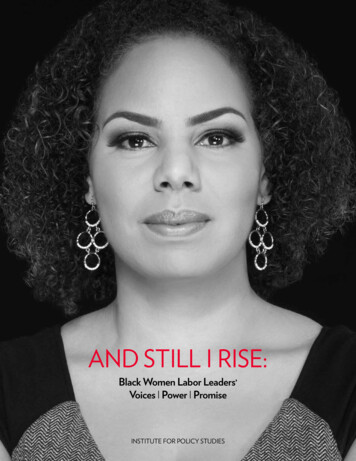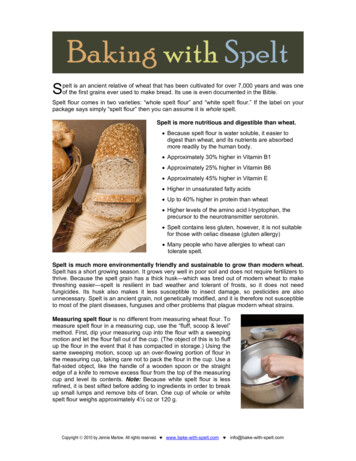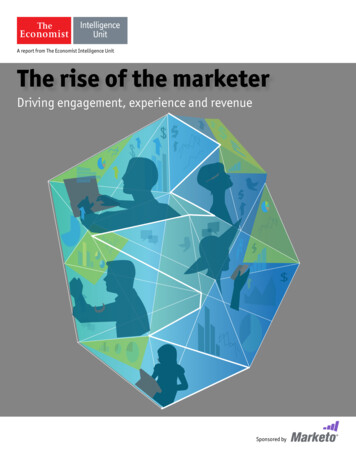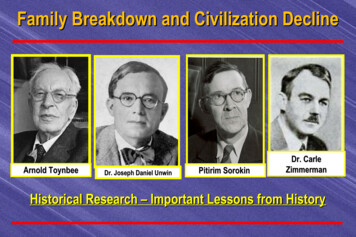
Transcription
And Still I RIse:Black Women Labor Leaders’Voices I Power I PromiseInstitute for Policy Studies
And Still I RIse:Black Women Labor Leaders’Voices I Power I Promise
To obtain a copy of the report, please contact:Institute for Policy Studies Communications Department1112 16th St. NW, Suite 600Washington, DC 20036E-mail requests for hard copies of the report tocomteam@ips-dc.orgTo download a copy, please visit:www.ips-dc.org or www.and-still-i-rise.org 2015Institute for Policy Studies (IPS) 1978“Still I Rise” from AND STILL I RISE by Maya Angelou.“Still I Rise” from AND STILL I RISE by Maya Angelou, copyright 1978 by Maya Angelou. Used by permission ofRandom House, an imprint and division of Penguin Random House LLC. All rights reserved. Any third-party useof this material, outside of this publication, is prohibited. Interested parties must apply directly to Penguin RandomHouse LLC for permission.As Washington’s first progressive multi-issue think tank, the Institute for Policy Studies (IPS) has served as a policyand research resource for visionary social justice movements for over four decades—from the anti-war and civilrights movements in the 1960s to the peace and global justice movements of the last decade. Some of the greatestprogressive minds of the 20th and 21st centuries have found a home at IPS, starting with the organization’s founders,Richard Barnet and Marcus Raskin. IPS scholars have included such luminaries as Arthur Waskow, Gar Alperovitz,Saul Landau, Bob Moses, Rita Mae Brown, Barbara Ehrenreich, Roger Wilkins and Orlando Letelier. Today theInstitute’s work is organized into more than a dozen projects, reflecting our public scholars’ diverse areas of expertise.The Black Worker Initiative is a bold and exciting new effort launched by the Institute for Policy Studies, whichis deeply committed to helping achieve both the historic and contemporary aims of the labor and civil rightsmovements. Black workers have been particularly hard hit by the rising tide of inequality in today’s economy.We hope our Initiative will be a part of the solution to helping expand opportunities for black worker organizing andthereby greatly aid the revitalization of the U.S. labor movement as a whole. Indeed, the Initiative operates under thebelief that black workers hold a key role in union revitalization. Without a platform for their voices and perspectives,a vital piece of the progressive movement is absent from the greater public discourse on race and economic and socialjustice. The Initiative seeks to be a forum for these important conversations, allowing relationships, ideas, and projectsto develop. The Initiative will use conferences, published reports, public education materials, and mainstream andsocial media in framing a road map to how black worker organizing can be an ongoing vehicle for the preservationof the labor movement and the promotion of civil rights and racial and economic justice.And Still I Rise: Black Women Labor Leaders’ Voices i Power i Promise
ContentsForeword by The Honorable Donna F. Edwards,United States House of Representatives1Introduction: A Labor of Love4Voices Leadership: Let Leaders Lead9Power Organizing Black Women: Labor’s Lowest Hanging Fruit47Promise Policy: Making Work Pay for Black Working Women89Into Daybreak: RecommendationsInsert: National Survey of Black Women in LaborAnd Still I Rise: Black Women Labor Leaders’ Voices i Power i Promise134
acknowledgeMENTSProject Director: Marc BayardAuthor: Kimberly Freeman BrownResearchers: Diana A. Torres Valverde, Erin Johansson, Haylie JacobsonSurvey Analyst: Linda S. Carr, Ph.D.Editors: Mike Tucker, Geri Coleman TuckerAdvisory Committee: Arlene Holt Baker, Professor Dorian Warren, Carol Joyner, Professor Marcia ChatelainPhotographer: Jacqueline HicksGraphic Designer: Deepika MehtaCelebrity Make-Up Artist: Letitia ThornhillProject Assistants: Javiera Alarcon, Erica Simpson, Briana TubayaWe gratefully acknowledge John Cavanagh, IPS Director; Sarah Anderson, IPS Global Economy Project Director; andLaShawn Walker, IPS Operations Associate, for their assistance in completing this project.This report would not have been possible without the generous support of the American Federation of Teachers(AFT), Communications Workers of America (CWA), the Discount Foundation, the Ford Foundation, InPartnershipConsulting, Inc., Laborers’ International Union of North America (LIUNA), Moriah Fund, Ms. Foundation forWomen, Polk Bros. Foundation, the Service Employees International Union (SEIU), the United Steelworkers (USW),and the Woods Fund of Chicago.The opinions and conclusions expressed herein do not necessarily represent the views or positions of these funders.For more information about IPS or the Black Worker Initiative or to make a tax-deductible contribution to supportIPS’s work, please visit: www.ips-dc.org or call the development office at 202.234.9382.And Still I Rise: Black Women Labor Leaders’ Voices i Power i Promise
Why Black WomenNeed Unions,Why Unions NeedBlack WomenForeword by The Honorable Donna F. Edwards,United States House of RepresentativesBlack women in America work. Hard.Yet our hard work has too often beenexploited and unrecognized, withtremendous consequences for families that relyon the income of black women, who are threetimes more likely than white women to be singleheads of households with children under theage of 18.And despite the fact that black women leadall women in labor force participation—evenwhile mothers of small children—their hardwork does not pay. Black women earn just 64cents on every dollar earned by white men; andare underrepresented in fields that pay familysupporting wages.In the public sector, a segment of our economywhere black women once fared relatively better,the effects of the Great Recession have beenparticularly devastating. Prior to the economicdownturn, the wage gap between black andwhite workers was less in the public sectorthan in the overall economy. These jobs greatlycontributed to building the black middle class.But the disproportionate share of women andAfrican Americans working in state and localgovernments translated into higher rates of jobloss for both groups in these sectors during therecession, according to the Economic PolicyInstitute.Perhaps because of these systemic and structuralgender- and race-based economic traps, blackworking women have turned to the power oflabor unions to escape poverty and workplacediscrimination. In 2014, black women (13.5percent) were only second to black men(15.8 percent) in having the highest unionrepresentation rate compared with other race orgender groups. This reality is not accidental. Asreported by the Black Women’s Roundtable in itsBlack Women in the United States, 2014: Progressand Challenges report, black women who workAnd Still I Rise: Black Women Labor Leaders’ Voices i Power i Promise1
under collective bargaining agreements earnhigher wages and enjoy greater access to benefitsthan women of all races and ethnicities who arenot unionized. In fact, for black women whoare low-wage earners, union membership wasa greater factor than education in determiningincreased wages and benefits.While black women’s high union membershiprate is little known, an even more importantfact has gone virtually unnoticed by thelabor movement and the broader progressivecommunity: the success of black women andother women of color as union organizers. Inthe groundbreaking 2007 article Race, Gender,and the Rebirth of Trade Unionism, by KateBronfenbrenner and Dorian Warren, extensiveresearch of National Labor Relations Board dataon union elections revealed that women of colorhave the highest election win rates among alldemographic groups. Researchers found that“units with a majority white men have the lowestwin rates (35 percent) compared to units thatare majority women of color (82 percent).” Andvictory margins are even greater—an astounding89 percent—when the lead organizer is awoman of color in units with over 75 percentwomen of color.Traditionally such expertise, acumen and trackrecords of success are rewarded with agendasetting leadership opportunities. Yet blackwomen’s organizing achievements have nottranslated into proportionate leadership withinthe labor and women’s movements or in civilrights and economic justice organizations.2The invisibility of black women’s laborleadership not only is of consequence toAfrican Americans, but it is significant in lightof shifting national population demographics.Other important factors that support the needto build on black women’s emerging leadershipare the rapid decline of union density and therelated rise of income inequality; retirementinsecurity; and high poverty rates and othereconomic indicators. Learning more abouthow black women lead in the labor movementis one step toward mining and leveragingblack women’s labor organizing success forthe advancement of workers’ rights, which isof critical importance to sustaining America’smiddle-class and working-class families.In much the same way as the victories of thecivil rights movement greatly benefitted whitewomen and other marginalized Americans,the leadership of black women can and shouldbe brought to bear in advancing economicpolicies of importance to all working families—including paid sick and family leave, pay equity,and living wages.And Still I Rise is proof that it is time for thestory about black women in America to berewritten. The insights, admonitions, affections,disappointments and aspirations expressed bythe 27 black labor women in this report shouldnot be taken lightly. They are critical pieces ofa playbook for saving and restoring the labormovement and strengthening African Americanand working-class families across our nation.And Still I Rise: Black Women Labor Leaders’ Voices i Power i Promise
Still I RiseMaya Angelou, 1928–2014You may write me down in historyWith your bitter, twisted lies,You may trod me in the very dirtBut still, like dust, I’ll rise.You may shoot me with your words,You may cut me with your eyes,You may kill me with your hatefulness,But still, like air, I’ll rise.Does my sassiness upset you?Why are you beset with gloom?‘Cause I walk like I’ve got oil wellsPumping in my living room.Does my sexiness upset you?Does it come as a surpriseThat I dance like I’ve got diamondsAt the meeting of my thighs?Just like moons and like suns,With the certainty of tides,Just like hopes springing high,Still I’ll rise.Out of the huts of history’s shameI riseUp from a past that’s rooted in painI riseI’m a black ocean, leaping and wide,Welling and swelling I bear in the tide.Did you want to see me broken?Bowed head and lowered eyes?Shoulders falling down like teardrops,Weakened by my soulful cries?Does my haughtiness offend you?Don’t you take it awful hard‘Cause I laugh like I’ve got gold minesDiggin’ in my own backyard.Leaving behind nights of terror and fearI riseInto a daybreak that’s wondrously clearI riseBringing the gifts that my ancestors gave,I am the dream and the hope of the slave.I riseI riseI rise.And Still I Rise: Black Women Labor Leaders’ Voices i Power i Promise3
You may write me down in historyWith your bitter, twisted lies,You may trod me in the very dirtBut still, like dust, I’ll rise.Maya Angelou, Still I Rise4And Still I Rise: Black Women Labor Leaders’ Voices i Power i Promise
Introduction:A Labor of LoveBy Kimberly Freeman Brown and Marc BayardAfter spending over 25 combined yearspromoting the trade union movementand protecting the right to organize inthe United States and around the world, we seethis report as a love letter of sorts.community’s hard-fought social and economicgains are quickly being rolled back as structuralinequality grows—not only threatening AfricanAmericans, but the equality and democracy ofU.S. residents more broadly.First and foremost, it is a love letter to the blacklabor women within these pages and to theirsisters all over the nation who do not yet haveunions. They are the grandmothers and motherswho sit regally in church pews each Sunday andinvisibly clean homes Monday through Saturday.They are our Southern aunts; our African,Afro-Latina and Caribbean-born sisters andcousins who work hard on the job and harder athome to make sure that their children’s dreamsare less deferred than their own. And they aretried and tested labor activists who break downbarriers and work to build a better economy foreach other and for all workers as rank-and-filemembers, shop stewards, organizers, electedlabor officials, and leaders of worker centersand member organizations for workers who areoutside of labor law protections.It is our heartfelt desire that this report remindsblack women, and shows others the power ofblack women to make a way out of no way andrise above these barriers that stand between themand true economic and social justice.The roles they play in their families andcommunities, on the job and in their unions areacts of resistance against everything that AfricanAmericans are up against. The statistics onAfrican American wealth and wage inequality,unemployment, mass incarceration, policebrutality and poverty are daunting. The blackMany of our years working within the labormovement have been spent convincingpeople—policymakers, progressive friends, anddisillusioned black workers—of labor’s virtue.For some, personal experiences or second-handknowledge of racism and sexism within unionshas been enough to cause them to back away.Second, this report is our love letter to thelabor movement—offering sometimes tough,but always unflappable affection. We knowwhat some may have forgotten. That if you areconcerned about the economic advancement ofblack women, families and communities, youmust think twice before you dismiss the value andimportance of the labor movement. No questionabout it, the fact that black women covered bycollective bargaining agreements fare better thantheir counterparts without one makes unionsworth fighting for.And Still I Rise: Black Women Labor Leaders’ Voices i Power i Promise5
Others, especially young people, are ambivalentbecause they do not know people who belong tounions.And all too often, policy strategies by civil rights,women’s and progressive organizations to addresseconomic issues facing African Americans andall working families do not include organizingworkers into unions as part of the solution.In many ways, these realities bear witness to thedistance labor still has to go in finding authenticways to root out persistent discrimination andinequality within and to build true partnershipsoutside of itself. We believe that the multifaceted nature of black women’s identity, theirexpertise as activists and organizers, and theurgency of their economic reality places them inthe perfect position to lead new efforts to makethese connections real, lasting, and capable ofproducing winning results.Despite the tremendous potential of wideningleadership opportunities for black women, oneof the biggest challenges of this project has beenconvincing potential supporters of the value offocusing on black women. “Why not women ofcolor or all women?” was a common questionwe were asked over and over again. Sadly, thequestion reinforces an often unconscious,but deeply held and historic belief that theexperiences of black women are not importantenough unless attached to others.Rising above these questions, we decided to focuson black women because we know that theyare, and have always been, “the miner’s canary”for workers in America. Black women haveexperienced for decades many of the economicand social ills now faced by others. Therefore, itstands to logic that making black women whole6raises the floor for all women—likely, for allworkers.The idea for this report emerged in October2013 when the Black Labor Scholars Network(now the Institute for Policy Studies’ BlackWorker Initiative) and Georgetown University’sKalmanovitz Initiative for Labor and the WorkingPoor hosted a two-day conference titled The Stateof the Black Worker in America. This event delveddeeply into the history of black workers and theirorganizing efforts; the current state and visionof black leadership within unions; innovativeand cutting edge black-led organizing across thecountry; and a gender-based analysis of blackorganizing.Little-known, groundbreaking research aboutthe effectiveness of black women’s leadershipin union organizing created a lot of buzz at theconference and begged an important question:Why has the organizing success of black womennot resulted in more black women serving inleadership positions that help shape the directionof the labor movement? We hit the road in searchof an answer. In our travels from the West Coastto the Deep South, we heard amazing storiesfrom incomparable women.And Still I Rise: Black Women Labor Leaders’Voices, Power and Promise gives the 27 amazingwomen we interviewed and the 467 whoresponded to the Institute for Policy Studies’National Survey of Black Women in Labor anopportunity to not only explore this questionfor themselves but, more important, to showthe labor movement a way forward. The reportis organized around three emerging themes—leadership, organizing and policy issues ofconcern to black labor women—and reflects thewomen’s unique position at the nexus of race,And Still I Rise: Black Women Labor Leaders’ Voices i Power i Promise
gender and class. More than giving a critiqueof what is wrong, the women offer insights intowinning organizing strategies, ways to build powerby linking arms with others, the value of openingopportunity to black women in nontraditionalfields; and what happens when white allies usetheir position and power to make room for theleadership of black women to emerge.These topics are explored through first-personnarratives of the women we interviewed anda summary of the national online surveyKimberly Freeman Brownresults. The report concludes with a series ofrecommendations to move the ideas within thesepages to action.It is our sincerest hope that this report is receivedin the spirit with which it was written—as a callfor labor to invest more in what the women saythat unions have done right. For it will be theseactions, matched with the tenacity and passionof black women for building a better world, thatwill allow all of us to declare Maya Angelou’simmortal words, “Still I Rise.”Marc BayardAnd Still I Rise: Black Women Labor Leaders’ Voices i Power i Promise7
Voices[ leadership ]And Still I Rise: Black Women Labor Leaders’ Voices i Power i Promise9
Bringing the gifts that my ancestors gave,I am the dream and the hope of the slave.I riseI riseI rise.Maya Angelou, Still I Rise10And Still I Rise: Black Women Labor Leaders’ Voices i Power i Promise
Let Leaders LeadUtilizing black women’s acumen and expertise to advancethe labor movement and the African American communityAfrican American women are the mostunderutilized leadership resource in theU.S. labor movement despite the factthat they belong to unions at higher rates than allother women.The U.S. Department of Labor’s Bureau of LaborStatistics (BLS) reports that in 2014 black womenaccounted for 12.2 percent of union membershipcompared to 10.1 percent for white women,8.9 percent for Latinas, and 11.8 percent for Asianwomen. However, in no union are the leadershipdemographics for black women representative ofthe union’s membership demographics.Results of the Institute for Policy Studies’ NationalSurvey of Black Women in Labor, confirm thistrend. Of the 467 women who responded to thesurvey, 89 percent reported being or having oncebeen a union member, staff or leader. And ofthose women, less than three percent reportedholding elected positions, less than five percentreported serving as president of a union or labororganization and less than 20 percent reportedholding senior staff positions at a director levelor higher.This leadership gap for black women is adetriment to the growth and survival of unions.According to extensive research of NationalLabor Relations Board (NLRB) elections byCornell University’s Kate Bronfenbrenner andColumbia University’s Dorian Warren, thehighest win rate, 89 percent, occurs for unionelections when women of color comprise amajority of the workforce and when organizersare women of color. Coupled with theaforementioned data on union membership rates,black women are labor’s lowest hanging fruit—the workforce most receptive to organizing.However, the limited opportunity for blackwomen to assume influential positions in unionswill likely continue to mean that organizing blackwomen—or fully integrating them strategicallyinto political, legislative, corporate and othercampaigns—will not be a high priority for thelabor movement.Unfortunately, the underrepresentation of blackwomen in the top ranks of leadership is not anisolated phenomenon in American society. Evenwhen skills, education and other indicators areheld constant, black women are often overlookedfor opportunities to make or influence thedecisions of businesses, government, nonprofitsand movements in nearly all sectors of society.According to both the Center for AmericanProgress and Catalyst, African Americanwomen occupy 5.3 percent of managerial andprofessional positions in corporations. Similarly,less than five percent of all nonprofit boarddirectors are women of color. And in the currentCongress, women of color make up only 6.2percent of members.And Still I Rise: Black Women Labor Leaders’ Voices i Power i Promise11
Even worse, without acknowledgement orapology, these same institutions rely heavily onthe labor of black women to get things done.It is time for things to change. And in some ways,things are changing. The rise of leaders profiledin this report—such as United SteelworkersAssistant Legislative Director Roxanne Brownand Wisconsin Jobs Now Executive DirectorJennifer Epps-Addison—is a testament to thenew, emerging face of labor that is increasinglyyoung, female, immigrant, and of color. Theirachievements and leadership call us to considerhow we make room for more Roxannes andJennifers to rise through the ranks.We explored with the women profiled in thisreport several different facets of this question,including whether they saw themselves asleaders; what they need to further developtheir leadership; and the barriers that must beremoved so that they can innovate, organize andwin union elections and better wages, workingconditions and benefits for workers and thebroader community. From our interviews andthe national survey, the following three distinctthemes emerged.First, black women want to lead. Regardlessof the stage they are at in their careers or theircurrent positions in the workplace and withinlabor, these women are not shrinking violets.About 65 percent of those who took the nationalsurvey stated that they aspire to become a unionleader. And their desire to lead does not comefrom an ego-centered place. Instead, it comesfrom a deep desire to make sure that the voices,concerns and ideas of those they serve as shopstewards, organizers and labor leaders are heard.For those who have risen up the ranks and nowsit at decision-making tables where they are often12the first black woman, or one of few—they seethe value in their place not for themselves butfor members who look like them. “More blackwomen in leadership positions allows more of abalance when approaching concerns and issuesfaced by black women, providing a seat at thetable that has equal voice as others at the table,”explains a national survey respondent.And perhaps, this national survey respondentsays it best, “The current leadership needs tounderstand that we are not trying to replaceanyone already at the table. We want thosealready at the table to move over so we have a seatat the table. We recognize the value of workingtogether, creating partnerships and collaborating.”Second, the labor movement does not havea leadership development problem whenit comes to black women, it has a leadershipopportunity problem. In 2002 the InternationalLabor Organization (ILO) published a reporttitled, Promoting Gender Equality: A ResourceKit for Trade Unions, that found union rules andprocedures do not encourage women to takeon leadership positions in the United States andthroughout the world. For example, nearly 70percent of the women who responded to thenational survey said that unions had investedin their leadership development, but almost 50percent of them agreed that they felt impeded inutilizing their leadership potential because of aglass ceiling. This suggests a structural issue thatleadership training programs alone—regardlessof how effective—cannot address. As the ILOreport attests, for unions to be credible, womenneed to be adequately represented and involvedat all levels of the union. And as one surveyrespondent said, “[Labor should make] sure wehave the same opportunities as others, who arenot black, to job promotion.”And Still I Rise: Black Women Labor Leaders’ Voices i Power i Promise
In interview after interview, black women laborleaders acknowledged that white and blackmen and white women in leadership positionsplayed important roles in their ascent withinunions. Replicating this experience is essential.According to findings published by the HarvardBusiness Review, women have mentors at workbut they do not have the type of mentors whouse their influence to advocate on their behalf forgreater opportunity. And those are exactly thetypes of mentors women need to advance in theircareers.Other women interviewed mentioned the rolethat training and apprenticeship programs, suchas the Nontraditional Employment for Women(NEW) program in the building and constructiontrades industry, have played in opening doors.Expanding leadership development opportunitieslike these must be matched with expandingopportunities to lead. “Increase leadership rolesfor black women,” said one national surveyrespondent. “Create a pipeline to leadership forblack women where they can be the decisionmakers.”Third, black women at all levels wantgreater opportunities for connection andmentorship—especially to one another. Thewomen we interviewed often spoke of theinformal circles of support that they have formedfor themselves. They recognize, however, thatthese unofficial support systems should becomplemented by more formal mentorshipchannels. There is no mystery why mentorshipwas one of the most commonly mentionedthemes in both the interviews and the nationalsurvey. Research shows that mentoring is one ofthe most important and highly valued aspects ofworkplace leadership development programs forwomen in unions. Mentoring in the workplacealso tends to lead to more promotions over thecourse of an employee’s career. Said one nationalsurvey respondent, “We need more mentorsfor women coming up through the ranks.Collectively, we have representation. However,when you break it down, black women aresprinkled here and there. It is important to find away for women to connect and build each otherup in this movement.”In conclusion, the stories of the women profiledin the leadership section of this report revealeverything that the labor movement has to gainby opening the doors of opportunity wider toblack women. From Jennifer Epps-Addison,we learn the value of investing in the leadershipdevelopment of the membership. From PierretteTalley we learn that amazing victories can be wonwhen leaders with new perspectives are in place.From Valerie Ervin and Karen Lewis, we learnthe importance of leveraging all that is learned inunions for greater opportunities to serve insideand outside of them. And from Dr. Toni Lewis welearn that black women understand the strategicvalue of union membership and the labormovement as a critical force for the economicand social advancement of their families andcommunities.Their stories beg the question: Can labor now seethe strategic value of black women?And Still I Rise: Black Women Labor Leaders’ Voices i Power i Promise13
Clayola BrownPresident, A. Philip Randolph Institute I Washington, DC“And together we nurtured one another.”The importance of mentoring in shaping young and senior leadersIn 2004, Clayola Brown became the first female president of the A. Philip Randolph Institute,the oldest constituency group of the American Federation of Labor-Congress of IndustrialOrganizations (AFL-CIO), which has promoted racial equality and economic justice since itsfounding in 1965. Brown succeeded iconic labor and civil rights leaders Randolph and BayardRustin and has skillfully led the organization into the 21st century.Her lifelong commitment to labor activism began in the early 1960s, when she was just a teenager,in her hometown of Charleston, South Carolina. She and her mother were part of a successfuleffort to organize the Manhattan Shirt Factory in Charleston. Around that time, there was a hugeinflux of northern manufacturing companies relocating to the South to take advantage of the lowunionization rate in the region. In the 1970s, Brown played a role in organizing employees of textilegiant J.P. Stevens & Co. In 1980, after a 17-year struggle, over 3,000 workers won a contract throughthe newly formed Amalgamated Clothing and Textile Workers Union. Brown eventually becameeducation director for the union and played a pivotal role in helping its 500,000 members negotiatebetter contracts. In 1995, the union merged with the International Ladies’ Garment Workers’ Unionand formed the Union of Needletrades, Industrial and Textile Employees (UNITE). Brown served onthe AFL-CIO Executive Council from 1995 to 2005.Brown’s story highlights her commitment to making room for the next generation of black tradeunionists, a passion birthed in her own experience of being nurtured and mentored by her motherand other black women in the labor movement as well as by white union brothers and sisters.Brown graduated from Florida A&M University in Tallahassee,
Maya Angelou, Still I Rise. And Still i RiSe: BlAck Women lABoR leAdeRS’ VoiceS I PoWeR I PRomiSe 5 A fter spending over 25 combined years promoting the trade union movement and protecting the right to organize in the United States and around the world, we seeFile Size: 2MBPage Count: 144










